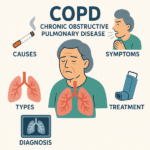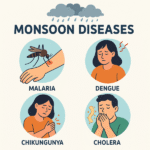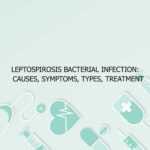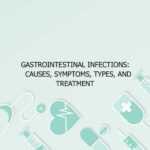Now Reading: Monsoon Diseases: Causes, Symptoms, Types, and Treatment
-
01
Monsoon Diseases: Causes, Symptoms, Types, and Treatment
Monsoon Diseases: Causes, Symptoms, Types, and Treatment
The monsoon season brings much-needed relief from scorching summer temperatures, replenishing water bodies and rejuvenating the environment. However, with the arrival of rains, a surge in humidity, water stagnation, and contaminated food and water creates ideal conditions for the proliferation of various diseases. These Monsoon Diseases range from bacterial and viral infections to vector-borne and fungal ailments. Understanding their causes, symptoms, types, and treatments is crucial for prevention and timely intervention.
Causes of Monsoon Diseases
The primary cause of Monsoon Diseases is the sudden shift in climate conditions that facilitates the growth and transmission of pathogens. The most notable causes include:
- Stagnant Water: Accumulated rainwater in open containers, potholes, and drains becomes breeding grounds for mosquitoes, leading to diseases like dengue, malaria, and chikungunya.
- Contaminated Water Supply: Drinking or using impure water often leads to waterborne illnesses such as cholera, typhoid, and hepatitis A and E.
- Increased Humidity: High humidity levels favor the growth of mold, fungi, and bacteria, triggering respiratory infections and skin conditions.
- Spoiled Food: Due to inconsistent refrigeration and moisture, food spoils easily, becoming a source of gastrointestinal infections.
- Poor Sanitation: Overflowing sewage systems during monsoon can lead to fecal contamination of food and water supplies, escalating disease spread.
Symptoms of Monsoon Diseases
Symptoms vary based on the type of disease but may overlap due to common modes of transmission and physiological effects. Common symptoms include:
- Fever: Usually high-grade and persistent in viral and vector-borne diseases.
- Vomiting and Diarrhea: Seen in waterborne infections like cholera and typhoid.
- Body Aches and Fatigue: Common in dengue, malaria, and viral fevers.
- Cough and Cold: Often triggered by respiratory infections and allergies.
- Skin Rashes: Resulting from fungal or bacterial skin infections.
- Jaundice and Liver Dysfunction: Indicative of hepatitis A or E.
- Respiratory Issues: Triggered by mold spores or air-borne pathogens.
Types of Monsoon Diseases
Waterborne Diseases
- Cholera: Caused by Vibrio cholerae, it leads to severe diarrhea and dehydration.
- Typhoid: Caused by Salmonella typhi, manifests as high fever, abdominal pain, and lethargy.
- Hepatitis A & E: Inflammation of the liver due to contaminated water.
Vector-borne Diseases
- Malaria: Spread by the female Anopheles mosquito; symptoms include chills, fever, and sweating.
- Dengue: Transmitted by Aedes aegypti mosquitoes; it causes rashes, joint pain, and bleeding in severe cases.
- Chikungunya: Similar to dengue but characterized by intense joint pain.
Airborne and Respiratory Infections
- Influenza: Cold, cough, body aches, and respiratory distress.
- Common Cold and Flu: Triggered by viruses, spreads rapidly in crowded and damp environments.
Skin and Fungal Infections
- Athlete’s Foot and Ringworm: Caused by prolonged exposure to moisture and poor hygiene.
- Eczema and Dermatitis: Often exacerbated due to wet clothing and fungal proliferation.
Treatment of Monsoon Diseases
Treatment of Monsoon Diseases depends on accurate diagnosis and the nature of the infection:
- Antibiotics and Antivirals: Used for bacterial infections (e.g., typhoid, cholera) and antiviral therapy for hepatitis or flu.
- Antimalarial and Antidengue Therapy: Drugs like chloroquine or artesunate are used for malaria, while supportive care is essential in dengue.
- Hydration Therapy: Oral Rehydration Salts (ORS) and intravenous fluids are crucial in waterborne diseases.
- Antifungal Medications: Topical creams or oral antifungals are prescribed for fungal infections.
- Symptomatic Relief: Paracetamol for fever, antihistamines for allergies, and bronchodilators for respiratory issues.
Preventive Measures
- Use mosquito repellents and nets.
- Avoid street food and unfiltered water.
- Maintain personal and environmental hygiene.
- Dry clothes thoroughly before wearing.
- Keep surroundings dry and clean.
- Get vaccinated where applicable (e.g., hepatitis A vaccine).
Table: Monsoon Diseases – Types and Key Symptoms
| Disease | Common Symptoms |
|---|---|
| Cholera | Watery diarrhea, dehydration, nausea |
| Typhoid | High fever, weakness, abdominal pain, constipation |
| Hepatitis A & E | Jaundice, dark urine, fatigue, nausea |
| Malaria | Chills, fever, sweating, headache |
| Dengue | High fever, skin rashes, muscle and joint pain |
| Chikungunya | Severe joint pain, rash, fever |
| Influenza | Cough, cold, fever, fatigue |
| Common Cold | Sneezing, nasal congestion, sore throat |
| Ringworm | Itchy, red, circular rash |
| Athlete’s Foot | Itching, cracked skin, burning sensation |
Frequently Asked Questions on Monsoon Diseases
What are the most common Monsoon Diseases and why do they occur so frequently during the rainy season?
The most common Monsoon Diseases include dengue, malaria, cholera, typhoid, and viral flu. These diseases occur frequently during the rainy season due to increased humidity and the accumulation of stagnant water that supports mosquito breeding. Additionally, poor sanitation and contaminated food or water sources act as catalysts for gastrointestinal infections like cholera and typhoid. The dampness and moisture also encourage fungal and respiratory infections. Collectively, these environmental and hygienic issues make monsoons a high-risk period for infectious diseases. Being aware of Monsoon Diseases and implementing proactive measures is essential for public health safety.
How can individuals protect themselves from Monsoon Diseases?
Protection against Monsoon Diseases begins with maintaining good hygiene, ensuring access to clean drinking water, avoiding raw or roadside food, and wearing full-length clothing to minimize mosquito bites. Using insect repellents, mosquito nets, and covering stored water containers helps reduce vector breeding. It’s also advisable to avoid walking through floodwater, as it can carry bacteria and viruses. Boosting immunity through a balanced diet and staying indoors during mosquito peak hours also supports prevention. Awareness about Monsoon Diseases, coupled with prompt medical intervention, plays a pivotal role in managing outbreaks.
Are Monsoon Diseases dangerous and can they become life-threatening?
Yes, some Monsoon Diseases can become life-threatening if not treated promptly. Dengue, for example, can progress to dengue hemorrhagic fever, causing internal bleeding and low platelet count. Malaria can lead to cerebral malaria, which affects the brain. Cholera causes severe dehydration that can be fatal without rehydration therapy. Hepatitis A and E may cause liver failure in vulnerable populations. Therefore, awareness about the symptoms and early diagnosis of Monsoon Diseases is crucial. Health education, prompt medical attention, and public health interventions can significantly reduce mortality rates associated with these diseases.
Why do Monsoon Diseases affect children and elderly people more severely?
Children and the elderly are more vulnerable to Monsoon Diseases due to weaker or compromised immune systems. Children often engage in outdoor activities and may unknowingly consume contaminated food or water. Their developing immunity makes them more susceptible to infections. The elderly, on the other hand, may suffer from underlying health conditions like diabetes or respiratory ailments, which exacerbate the impact of Monsoon Diseases. Ensuring a nutritious diet, maintaining hygiene, and monitoring symptoms closely in these groups is essential for minimizing health risks during the monsoon season.
Can Monsoon Diseases be prevented with vaccines?
Yes, some Monsoon Diseases can be prevented through vaccination. Vaccines are available for diseases like hepatitis A and typhoid, which are common during monsoon. While there is currently no vaccine for dengue or chikungunya widely available in all regions, research is ongoing. Vaccination, when combined with hygiene practices and public health efforts, can drastically reduce the incidence of Monsoon Diseases. Consulting a healthcare provider about travel vaccinations and routine immunizations before the rainy season is a smart preventive step for individuals and families.
What role does the government play in controlling Monsoon Diseases?
Governments play a vital role in managing and preventing Monsoon Diseases through public health campaigns, sanitation programs, vector control measures, and emergency healthcare services. Initiatives like fogging to kill mosquitoes, setting up temporary clinics during outbreaks, providing clean drinking water, and issuing health advisories are crucial. Educating the public through media campaigns about symptoms and preventive steps against Monsoon Diseases fosters community participation. Government partnerships with NGOs and local bodies also enhance the reach and effectiveness of disease prevention and management during monsoon.
What is the difference between dengue and chikungunya in Monsoon Diseases?
While both dengue and chikungunya are mosquito-borne Monsoon Diseases transmitted by the Aedes aegypti mosquito, they have distinct differences. Dengue often presents with a sudden high fever, severe headache, pain behind the eyes, and a significant drop in platelet count, which may lead to bleeding. Chikungunya, on the other hand, is marked by extreme joint pain that can persist for weeks, even after the fever subsides. Blood tests are required to confirm diagnosis, and although both diseases lack specific antiviral treatment, supportive care varies based on symptoms. Accurate diagnosis is critical to manage these Monsoon Diseases effectively.
How do Monsoon Diseases spread and what are their modes of transmission?
Monsoon Diseases spread through various means including contaminated food and water (cholera, typhoid), mosquito bites (malaria, dengue), inhalation of air-borne pathogens (influenza), and skin contact with infected surfaces (fungal infections). Poor sanitation, waterlogging, and overcrowded living conditions enhance their transmission. Preventing the spread involves proper sanitation, avoiding contact with infected persons, covering wounds, and disinfecting common areas. Personal hygiene and environmental cleanliness are key to breaking the chain of transmission for Monsoon Diseases.
What are the early warning signs of serious Monsoon Diseases?
Early signs of severe Monsoon Diseases include high-grade fever, unexplained bleeding or bruising, persistent vomiting, jaundice, confusion, and extreme fatigue. These may indicate diseases like dengue hemorrhagic fever, hepatitis, or malaria. Recognizing these symptoms early and seeking immediate medical care can prevent complications. Ignoring or misdiagnosing Monsoon Diseases can lead to organ failure, sepsis, or death. It is crucial for individuals and caregivers to act swiftly when symptoms escalate beyond the common cold or flu, particularly during the rainy season.
Can Monsoon Diseases lead to long-term complications?
Yes, some Monsoon Diseases can cause long-term complications if not treated properly. Hepatitis A or E can result in chronic liver damage in rare cases. Severe dengue may weaken the immune system or cause lasting platelet dysfunction. Chronic joint pain following chikungunya can affect mobility and quality of life for months. Similarly, untreated malaria may affect the brain or kidneys. Early detection and proper treatment are critical in preventing these long-lasting effects. Public health awareness about Monsoon Diseases should emphasize not just short-term symptoms but also potential chronic impacts.
Medical Journals on Monsoon Diseases
| Journal Title & Description | Author(s) |
|---|---|
| “Seasonal Prevalence of Waterborne Diseases During Monsoon” – Study on water contamination during rains | Dr. Neha Sharma, Dr. A. Roy |
| “Vector Dynamics in Monsoon and Its Impact on Urban Health” – Focus on mosquito breeding and disease spread | Dr. Sanjay Mehta |
| “Monsoon and Gastrointestinal Infections: An Epidemiological Review” – Link between food safety and monsoon outbreaks | Dr. Ritu Agarwal, Dr. K. Sinha |
| “Dengue and Chikungunya Co-infection During Monsoon Season” – Clinical study in tropical regions | Dr. P. Raghavan, Dr. I. Banerjee |
| “Fungal Skin Infections in Humid Climates: A Monsoon Perspective” – Dermatological observations in rural India | Dr. Lavanya Suresh |
| “Airborne Pathogens and Respiratory Infections During Monsoon” – Role of mold and allergens | Dr. Monica Patel |
| “The Effectiveness of Public Health Campaigns on Monsoon Disease Awareness” – Survey-based research | Dr. Rajeev Deshmukh |
| “Antibiotic Resistance in Monsoon-related Infections” – Resistance trends in waterborne pathogens | Dr. Kavita Narula |
| “Impact of Climate Change on Monsoon Disease Patterns” – How changing monsoons affect disease epidemiology | Dr. Amrita Paul |
| “Treatment Challenges in Pediatric Monsoon Diseases” – Focused on children’s health during monsoon | Dr. Pooja Anand |









